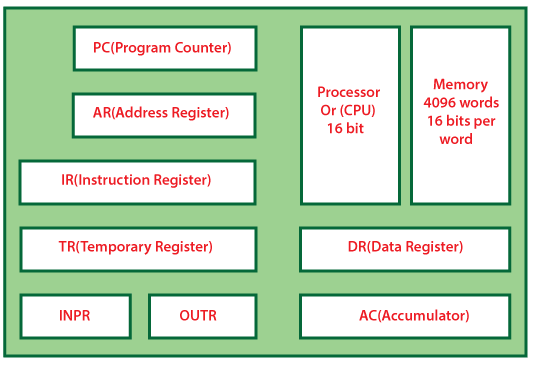RegistersA Register is a collection of flip flops. A flip flop is used to store single bit digital data. For storing a large number of bits, the storage capacity is increased by grouping more than one flip flops. If we want to store an n-bit word, we have to use an n-bit register containing n number of flip flops. The register is used to perform different types of operations. For performing the operations, the CPU use these registers. The faded inputs to the system will store into the registers. The result returned by the system will store in the registers. There are the following operations which are performed by the registers: Fetch:It is used
Decode:The decode operation is used to interpret the instructions. In decode, the operation performed on the instructions is identified by the CPU. In simple words, the decode operation is used to decode the instructions. Execute:The execution operation is used to store the result produced by the CPU into the memory. After storing this result, it is displayed on the user screen. Types of RegistersThere are various types of registers which are as follows: 
MAR or Memory Address RegisterThe MAR is a special type of register that contains the memory address of the data and instruction. The main task of the MAR is to access instruction and data from memory in the execution phase. The MAR stores the address of the memory location where the data is to be read or to be stored by the CPU. Program CounterThe program counter is also called an instruction address register or instruction pointer. The next memory address of the instruction, which is going to be executed after completing the execution of current instruction is contained in the program counter. In simple words, the program counter contains the memory address of the location of the next instruction. Accumulator RegisterThe CPU mostly uses an accumulator register. The accumulator register is used to store the system result. All the results will be stored in the accumulator register when the CPU produces some results after processing. MDR or Memory Data RegisterMemory Data Register is a part of the computer's control unit. It contains the data that we want to store in the computer storage or the data fetched from the computer storage. The MDR works as a buffer that contains anything for which the processor is ready to use it. The MDR contains the copied data of the memory for the processor. Firstly the MDR holds the information, and then it goes to the decoder. The data which is to be read out or written into the address location is contained in the Memory Data Register. The data is written in one direction when it is fetched from memory and placed into the MDR. In write instruction, the data place into the MDR from another CPU register. This CPU register writes the data into the memory. Half of the minimal interface between the computer storage and the microprogram is the memory data address register, and the other half is the memory data register. Index RegisterThe Index Register is the hardware element that holds the number. The number adds to the computer instruction's address to create an effective address. In CPU, the index register is a processor register used to modify the operand address during the running program. Memory Buffer RegisterMemory Buffer Register is mostly called MBR. The MBR contains the Metadata of the data and instruction written in or read from memory. In simple words, it adds is used to store the upcoming data/instruction from the memory and going to memory. Data RegisterThe data register is used to temporarily store the data. This data transmits to or from a peripheral device.
Next TopicShift register
|
 For Videos Join Our Youtube Channel: Join Now
For Videos Join Our Youtube Channel: Join Now
Feedback
- Send your Feedback to [email protected]
Help Others, Please Share










